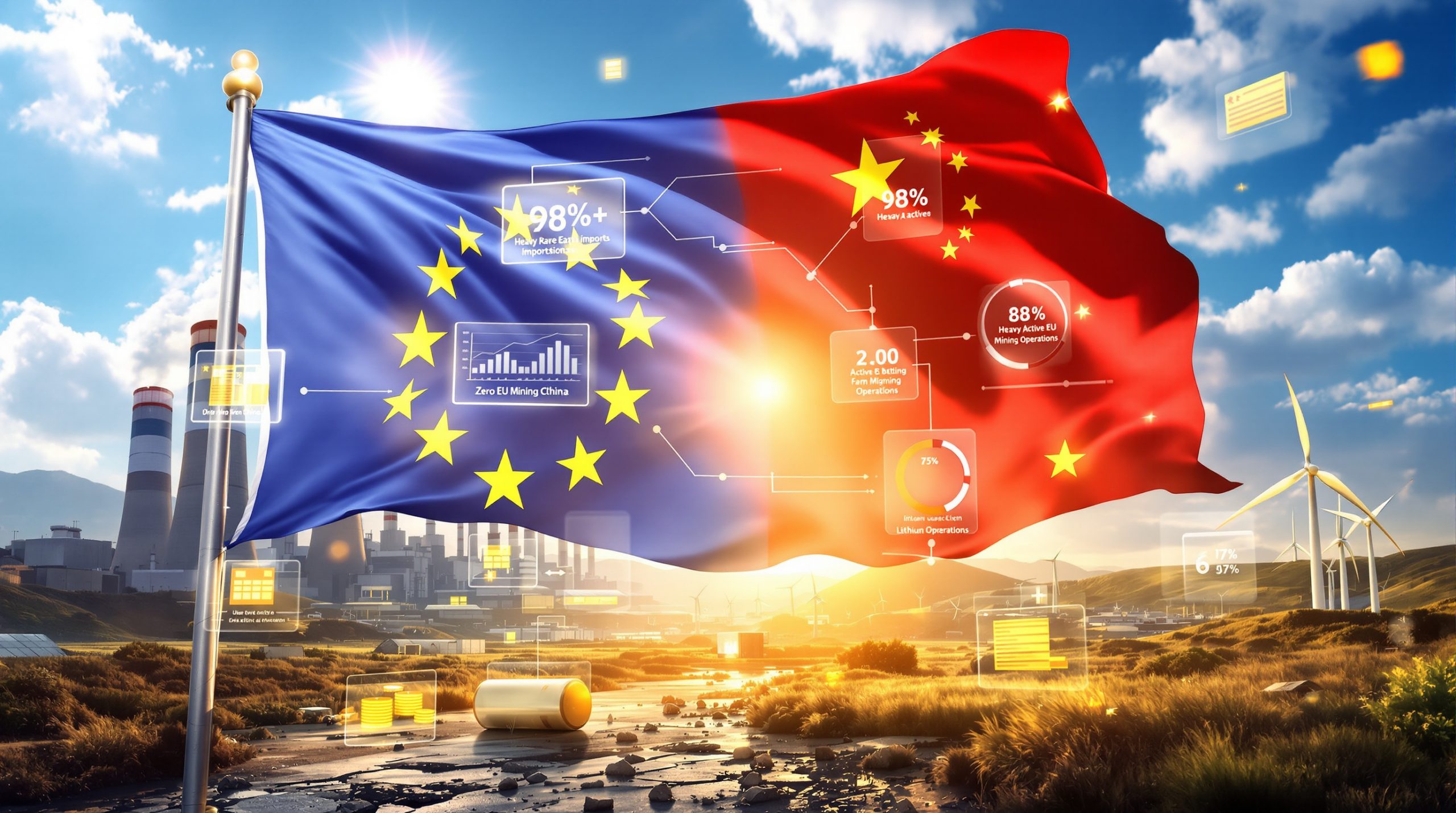How Does the Pentagon's AI Metals Program Work to Boost Western Supply Chains?
The transition of a key defense initiative to the private sector marks a significant shift in U.S. strategy for securing critical minerals supply chains. This comprehensive analysis explores how artificial intelligence is being deployed to counter China's dominance in metals markets and create new opportunities for Western suppliers.
What Is the Pentagon's AI Metals Program?
Origins and Development of the AI Initiative
The Open Price Exploration for National Security AI metals program was launched in late 2023 by the U.S. Department of Defense as a strategic response to China's dominance in critical minerals. This sophisticated artificial intelligence system was designed to predict supply and price fluctuations for essential metals used in defense and clean energy applications.
The program emerged from the Pentagon's recognition that traditional market intelligence was insufficient to address the complex challenges posed by China's growing control over critical mineral supply chains. By leveraging advanced digital mining innovation, the initiative aims to provide unprecedented visibility into future market conditions.
Transfer to the Critical Minerals Forum
In a significant development, the Pentagon has transferred control of this AI program to the Critical Minerals Forum (CMF), a non-profit organization established to facilitate supply deals between miners and manufacturers. This privatization represents a strategic pivot to encourage broader industry participation while maintaining the program's national security objectives.
Rob Strayer, president of the CMF, emphasized that the organization's primary goal is to "connect mining projects with potential investors and manufacturers needing secure metals supply" – creating a more transparent ecosystem for critical minerals transactions.
Key Stakeholders and Membership Structure
The CMF has attracted more than 30 mining companies, manufacturers, and investors as its first members, including:
- Major automotive manufacturer Volkswagen
- Copper producer South32
- Rare earths company MP Materials
- Defense contractor RTX
The organization held its first meeting with members in November 2024 and is now actively recruiting additional participants from the semiconductor, aviation, and defense sectors with free membership offers for the next 14 months while Pentagon funding continues.
Seth Goldstein, a senior equity analyst at Morningstar, noted that "any tool like the CMF that could help with price transparency would be welcome" in markets often characterized by opacity and manipulation.
How Does the AI Model Transform Metals Markets?
Technical Capabilities and Data Sources
The Pentagon's AI model draws on more than 70 mining-related datasets to provide unprecedented market intelligence, including:
- Price data from FactSet and Benchmark Mineral Intelligence
- Market analysis from specialized providers
- Non-public information from the U.S. Commerce Department
- Government geological surveys and production reports
- Environmental compliance documentation
This comprehensive data foundation allows the system to forecast market conditions up to 15 years into the future, accounting for potential disruptions like export restrictions or production changes.
What makes this initiative particularly powerful is its integration of both public and proprietary data sources, creating a more complete picture of global commodities insights than any previous system has achieved.
Addressing Market Manipulation Concerns
The AI model aims to calculate what metals should cost when all legitimate factors are considered—and Chinese market manipulation is excluded. This approach provides both buyers and sellers with greater confidence in the economic fundamentals of potential deals.
Nick Myers, an executive at rare earths processor Phoenix Tailings, highlighted that the CMF data provides valuable "negotiating leverage against manipulated prices" that have historically disadvantaged Western producers.
| AI Model Benefits | Traditional Market Challenges |
|---|---|
| Forecasts true production costs | Vulnerable to market manipulation |
| Projects long-term supply availability | Limited visibility beyond short-term |
| Simulates impacts of policy changes | Reactive rather than predictive |
| Focuses on lightly traded critical minerals | Dominated by Chinese producers |
| Facilitates direct supplier-buyer connections | Reliant on opaque intermediaries |
| Validates environmental compliance costs | Undervalues sustainability factors |
| Accounts for geopolitical risk premiums | Ignores supply security considerations |
Real-World Applications Taking Shape
The program is already generating tangible results. Nevada officials recently announced they would collaborate with the CMF and its AI model to attract copper smelting operations to the state—addressing a critical gap in U.S. processing capacity that currently forces the country to import nearly half its copper demand.
This represents a significant breakthrough, as the United States has struggled to establish new metals processing facilities despite abundant mineral resources. The AI model identified Nevada as an optimal location based on factors including energy costs, transportation infrastructure, and proximity to mines.
Why Is This Initiative Critical for Western Supply Chains?
China's Growing Control Over Critical Minerals
The privatization comes at a crucial moment as Beijing has begun restricting exports of essential minerals, highlighting the vulnerability of Western supply chains. Chinese companies have strategically dominated production of several critical materials:
- Overproduction of nickel and cobalt in Indonesia and Congo
- Control of rare earth elements processing (17 metals essential for magnets)
- Dominance in over 80% of global rare earths refining
- Export restrictions on germanium and gallium since 2023
- Strategic investments in lithium production worldwide
Liu Pengyu, spokesperson for the Chinese embassy in Washington, has claimed that China "manages exports per WTO rules," but Western analysts have noted patterns of market control that fall outside conventional trade regulations.
Creating Alternative Price Discovery Mechanisms
The CMF's approach represents one of the boldest efforts to transform how certain metals are bought and sold, particularly for:
- Lightly traded critical minerals without established market mechanisms
- Metals subject to market manipulation through strategic overproduction
- Materials with export restrictions that distort true market values
- Minerals with significant environmental compliance cost differentials
- Resources vulnerable to geopolitical supply disruptions
Brian Menell, CEO of battery metals investment firm TechMet, noted that "better modeling of markets is enormously valuable for green premium validation" – helping Western producers justify higher prices based on environmental compliance and sustainable practices.
Supporting Long-Term Supply Agreements
The AI model enables manufacturers to negotiate long-term supply deals with Western producers by providing confidence in future pricing and availability—even if Chinese suppliers temporarily drive down market prices through overproduction strategies.
This capability is particularly valuable for critical minerals like rare earths, where price volatility has historically deterred investment in Western production. By providing more stable price forecasts, the AI model reduces investment risk and encourages capital formation for new mining and processing projects.
What Challenges Does the Program Face?
Skepticism About Predictive Capabilities
Not all market observers are convinced the AI model will succeed. Ian Lange from the Colorado School of Mines has expressed doubt, comparing it to oil market predictions:
"Can we predict the price of oil better now than five years ago? The answer is no. Machine learning doesn't help."
This skepticism reflects legitimate concerns about the complexity of global commodities markets and the many variables—from geopolitics to technological disruption—that can influence prices in unpredictable ways.
Changing Established Trading Patterns
The program faces the challenge of transforming long-established trading patterns and convincing buyers to potentially pay premium prices for supply security rather than seeking the lowest possible cost.
This represents a significant cultural shift for procurement departments that have historically been evaluated primarily on cost containment rather than supply chain resilience. The success of the CMF will depend partly on whether corporate leadership increasingly values security over short-term savings.
Funding and Sustainability Questions
While DARPA is funding the program through at least 2029, the CMF must determine its long-term financial model:
- Potential tiered membership structure
- Basic free access versus premium paid data services
- Transition of intellectual property from Pentagon to CMF by early 2027
- Revenue-sharing agreements with data providers
- Potential government subsidies for national security applications
The organization's ability to establish a sustainable funding model will be critical to maintaining both independence and credibility beyond the initial Pentagon funding period.
How Might This Impact Global Metals Markets?
Potential for International Expansion
The CMF is actively pursuing international participation, with copper-rich Zambia and cobalt-producer Democratic Republic of Congo reportedly considering membership. This global approach could significantly enhance market transparency beyond U.S. borders.
Rob Strayer has emphasized the CMF's aim "to make markets transparent beyond U.S. borders," recognizing that effective critical minerals solutions require international coordination. The participation of resource-rich nations like Zambia could reduce their reliance on Chinese smelting infrastructure and create new pathways for direct trade with Western manufacturers.
Implications for Traditional Exchanges
The London Metal Exchange (LME) and other traditional metals trading venues may face new competitive pressures as the AI model introduces another variable into market dynamics. The LME is already struggling with rivals in Chicago and Shanghai attempting to capture market share for niche battery metals.
While the CMF isn't positioning itself as a trading platform, its price intelligence could influence contract negotiations that would otherwise reference LME benchmarks, potentially diminishing the exchange's role as the primary price setter for industrial metals.
Supporting "Green Premium" Pricing Models
As Western miners increasingly seek price premiums for environmentally responsible production, the market intelligence provided by the CMF model could help establish and validate these new pricing structures.
The AI model's ability to quantify the true costs of environmental compliance, ethical labor practices, and sustainability measures provides crucial validation for producers who need to justify higher prices to buyers. This could accelerate the emerging trend toward differentiated pricing based on production methods rather than treating all sources as equivalent.
What Does This Mean for the Future of Critical Minerals Supply?
Alignment with U.S. Policy Objectives
The privatization of the Pentagon's AI program aligns with broader U.S. government initiatives to secure critical minerals supply chains:
- President Trump's market reshaping has ordered his administration to boost domestic critical minerals production
- A study of potential tariffs on all U.S. mineral imports is underway
- The program supports the creation of more transparent market mechanisms
- Department of Energy programs focused on supply chain resilience complement the CMF's work
- Defense Production Act authorities may be leveraged for critical projects identified through the AI model
This multi-pronged approach reflects growing bipartisan recognition that critical minerals security represents a fundamental national interest requiring coordinated public and private sector action.
Creating New Investment Opportunities
The AI model could help direct investment toward critical minerals projects by providing greater confidence in future market conditions. For example, it could help manufacturers determine whether to:
- Invest directly in mining operations
- Sign off-take agreements with producers
- Commit to purchase agreements that enable project financing
- Form joint ventures with resource developers
- Participate in public-private consortia for processing facilities
Phoenix Tailings has already begun using CMF data to align prices with "actual production costs" rather than artificially suppressed market rates, creating a more sustainable business model for domestic rare earths processing.
Building Resilience Against Market Shocks
By enabling better forecasting of supply disruptions, the AI model helps manufacturers prepare for potential market shocks, such as predicting available nickel supplies in 2028 if the U.S. were to impose a 100% tariff on Indonesian imports.
This scenario-planning capability represents a significant advance in supply chain risk management, allowing companies to develop contingency plans for disruptions before they occur rather than scrambling to respond after markets have already been impacted.
FAQ: Understanding the Pentagon's AI Metals Program
How does the AI model differ from traditional market analysis?
The Pentagon's AI model combines over 70 datasets, including non-public information, to forecast market conditions up to 15 years ahead. Unlike traditional analysis, it can simulate the impact of policy changes, export restrictions, and other market disruptions with greater precision.
Will this program lead to higher prices for consumers?
The program assumes buyers might pay premium prices for supply security rather than seeking the lowest cost. While this could increase input costs, it aims to reduce long-term volatility and prevent sudden supply disruptions that could be more costly.
How does the program counter Chinese market influence?
By providing alternative price discovery mechanisms and facilitating direct connections between Western producers and buyers, the program reduces reliance on Chinese-dominated supply chains and creates more transparent markets for critical minerals.
Can small mining companies benefit from this initiative?
Yes, smaller producers like rare earths processor Phoenix Tailings see the CMF as providing negotiating leverage with potential customers by establishing U.S.-based prices for minerals tied to actual production costs rather than manipulated market prices.
Conclusion: A New Era for Critical Minerals Markets
The privatization of the Pentagon's AI metals program represents a significant evolution in how Western nations approach critical minerals security. By combining artificial intelligence with industry collaboration, the Critical Minerals Forum aims to create more transparent, resilient supply chains that reduce dependence on potentially unreliable sources.
While challenges remain in predicting complex market dynamics and changing established trading patterns, the initiative demonstrates a concrete step toward addressing the strategic vulnerability created by China's dominance in critical minerals. As the program develops, it may establish new paradigms for how these essential materials are valued, traded, and secured for both defense and clean energy applications.
This transformation comes at a pivotal moment as commodity super cycle trends intensify alongside the global energy transition and growing technological demands. The success of the Pentagon's AI metals program going private may ultimately be measured not just by the deals it facilitates, but by its contribution to a more sustainable, secure, and transparent global minerals marketplace. Furthermore, as outlined in recent mining and finance predictions, this initiative could fundamentally reshape investment flows into critical mineral projects worldwide.
Ready to Stay Ahead of Critical Mineral Market Shifts?
Discover how AI-powered real-time alerts can help you capitalise on emerging opportunities in the critical minerals sector before the market reacts. Visit Discovery Alert's discoveries page to see how their proprietary Discovery IQ model has identified significant mineral announcements that led to substantial returns for early investors.




